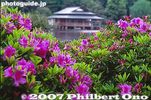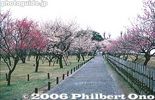 Image search results - "flowers" Image search results - "flowers" |

Welcome to IbarakiTrain platform of Kairakuen Station.
|
|

Train platform of Kairakuen Station
|
|

Train platform of Kairakuen Station
|
|

Plum Blossom Queen at Kairakuen StationShe was passing out maps of the garden. It was a nice touch to see two of these kimono beauties greeting us.
|
|

Plum Blossom Queen
|
|

Entrance to garden via Tokiwa Shrine. One of Japan's three most famous gardens, Kairakuen is especially noted for thousands of plum blossom trees which bloom in Feb. and March.One of Japan's three most famous gardens, Kairakuen is especially noted for thousands of plum blossom trees which bloom in Feb. and March.
|
|

Tokiwa Shrine, MitoDedicated to Lord Mitsukuni Tokugawa, the second lord of Mito, and Nariaki Tokugawa, the ninth lord of Mito and the one who built Kairakuen Garden.
|
|

Bonsai plum treesI bought one of these once and the flowers smelled good before they withred away. The tree also died soon afterward.
|
|

Crowd at Higashi-mon East GateThis was the defacto main gate and most crowded since it is closest to the train station.
|
|

Seibu Ikebukuro Line train station entrance at Ikebukuro, Tokyo. It takes about 90 min. from Ikebukuro to Yokoze Station via Tokkyu express train. Cheaper trains take 2 hours.
|
|

Way to Mogusaen Garden
|
|

Map of Kairakuen, a garden built in 1841 by Tokugawa Nariaki (1800-1860), the ninth Lord of Mito. It is one of Japan's three most famous gardens.
|
|

Seibu Ikebukuro Line train with shibazakura design.
|
|

Decorating the path to Mogusaen Garden
|
|

Pinickers
|
|

Seibu Ikebukuro Line Yokoze Station. Get off here for an easy walk to Hitsujiyama Park where the Shibazakura moss pink hill is. A tourist info office is on the left. 西武池袋線横瀬駅
|
|

Long uphill slope will keep you panting until the garden entrance.
|
|

Plum blossom-viewing picnickers
|
|

Tulip Festival ahead. Free admission. The Tulip Matsuri Festival comes on the heels of Hamura's Sakura Matsuri held in early April along the Tamagawa River.
|
|

You can buy a park entry ticket (300 yen) at a booth in front of Yokoze Station. Maps also available. Underpass at Yokoze Station.
|
|

Entrance to Mogusaen Garden
|
|

Red and white plum blossoms
|
|

Tulips everywhere. The Tulip Festival started in 1988 when a group started a flower and greenery campaign in the city.
|
|

Steps to garden
|
|
|
|

The tulip fields cover about 23,000 sq. meters. These are originally rice paddies. The tulips are grown when the rice paddies are not used during Nov.-May.
|
|

Entrance to Hitsujiyama Park. Show your ticket or buy it at the booth nearby.
|
|
|

White plum blossoms, the most common variety, and with the sweetest aroma.
|
|

Quite overwhelming with about 360,000 tulip bulbs.
|
|

If you go early in the morning, there are fewer people.
|
|
|
|
|

Quite spectacular when the flowers are in full bloom.
|
|

Shoren'an which is now a restaurant. 松連庵
|
|

Osaka-zuki red plum blossoms 大盃Osaka-zuki
大盃
|
|

Hamura Tulip Festival, Tokyo
|
|

These photos were taken in late April 2007. (Copyright year in the images are mistaken.)
|
|

Plum tree and Shoren'an
|
|

Plum tree grove, about a week too early.
|
|
|
|

It is not yet full bloom. A few patches of green.
|
|

One of the few plum trees in bloom in early Feb.
|
|

Fantastically-shaped plum tree
|
|
|
|

Nezu Station (Chiyoda Line) platform. Just follow the sign to get out the correct exit. 根津駅
|
|

On sunny days, great for taking pictures.
|
|

The cherry blossoms lining Sotobori Moat also look stunning from the road, Sotobori-dori in front of Kagurazaka.
|
|

Cherry blossoms along the Shakujii River, near Shin-Itabashi Station on the Mita subway line.
|
|

Plum blossoms
|
|

Konan Shomu plum blossom 江南所無Prunus mume Kounanshomu
|
|
|

Weeping cherry
|
|

On the street, just follow the signs to Nezu Shrine. Only a few minutes walk.
|
|
|

People in a long line waiting to enter Canal Cafe to either dine or rent a rowboat.
|
|

There are cherries on both sides of the river and a walking path on both sides.
|
|
|

Plum Blossom Queens in Kairakuen, Mito
|
|

Red tulips
|
|

Weeping cherry next to the water park.
|
|

Nezu Shrine torii gate 根津神社
|
|

Eight varieties of moss pink are planted. This is Autumn Rose. オータムローズ
|
|

Canal Cafe is right below the cherries. But notice empty tables despite the long line.
|
|

Entrance to one walking path with a poem monument.
|
|
|

Plum Blossom Queens in Kairakuen, Mito
|
|

Yellow tulips
|
|

Weeping cherries
|
|

ハナモモ はなかいど
|
|

Nezu Shrine torii gate 根津神社
|
|

Autumn Rose. Moss pink flowers have five petals with notches, looking like miniature cherry blossoms. The flowers are small. オータムローズ
|
|

Empty rowboats too.
|
|
|

Centerpiece plum tree but too early for flowers. 寿昌梅
|
|
|

Cherry trees along the Sotobori Moat. Formerly a moat of Edo Castle, this canal stretching from Iidabashi Station to Ichigaya Station along the Chuo Line.
|
|
|
|

The Bunkyo Tsutsuji Matsuri or Azalea Festival is held from April to early May at Nezu Shrine which has a slope filled with 50 varieties of azaleas.
|
|

Moss pink is therefore commonly called "shiba-zakura" which can be translated as "grassy cherry blossoms" or "lawn cherry blossoms."
|
|

Swan boats on Shakujii Pond. 石神井公園
|
|
|

Shoren'an and picnic tables
|
|

Winter-flowering cherry blossoms and Dai-Hondo Hall
|
|

Plum trees and Lake Senba
|
|
|
|

Azalea Garden and Nezu Shrine gate 楼門(国指定重文)
|
|
|
|
|

Cherry tree shadow
|
|

View of the city
|
|
|

Plum trees and Lake Senba
|
|
|
|
|

The azaleas usually reach full bloom in late April, but there are flowers which bloom later or earlier so there's always something in bloom during the festival period.
|
|

Little Dot. リットルドット
|
|
|
|
|

River wall
|
|

Winter-flowering cherry blossoms, Nishi-Arai Daishi, Tokyo 寒桜
|
|

Plum trees and Lake Senba
|
|
|
|
|

Little Dot are white flowers with a yellow dot at the center. リットルドット
|
|

Shakujii Pond 石神井池
|
|

Rowboats and low-hanging cherries.
|
|

Shakujii River sprinkled with fallen petals.
|
|
|
|
|
|

Azalea bushes and Ryotei teahouse
|
|
|
|
|

This bridge was recently rebuilt.
|
|

Little Dot
|
|
|
|

The end of the moat is also a good viewpoint.
|
|

Pleasant walking path.
|
|

Winter-flowering cherry blossoms 寒桜
|
|

Torano-o plum blossom (Tiger's Tail) 虎の尾
|
|
|
|

Hanamomo
|
|

The large slope of azalea bushes have walking paths where you can see and photograph the flowers up close.
|
|
|
|

The end of the moat is also a good viewpoint.
|
|
|
|

Flowering crab apple (Hanakaido in Japanese). This is early April. 花海棠
|
|
|

Pine trees and plum trees
|
|

Pine branches and azaleas
|
|

A bee's eye view.
|
|

Hanamomo
|
|

Nezu Shrine, Tokyo
|
|

McDaniel's Cushion マックダニエルクッション
|
|
|

How it looks from the end of the moat.
|
|
|

Flowering crab apple (Hanakaido in Japanese) 花海棠
|
|
|

Plum tree grove
|
|

Red and white azaleas
|
|
|
|

しゃが
|
|

Some bushes are in full bloom, while others are still too early.
|
|

McDaniel's Cushion are dark pink flowers. マックダニエルクッション
|
|

How it looks from the end of the moat.
|
|

A few bridges cross the river.
|
|

Flowering crab apple (Hanakaido in Japanese) 花海棠
|
|

Winter-flowering cherry blossoms 寒桜
|
|

Plum tree and train
|
|
|

McDaniel's Cushion
|
|
|
|
|

Flowering crab apple (Hanakaido in Japanese) 花海棠
|
|

Winter-flowering cherry blossoms 寒桜
|
|

Monument proclaiming Kairakuen as one of Ibaraki's 100 Best Sights
|
|
|
|

Entry to the azalea garden. 200 yen admission (actually a donation). Open 9am to 5 pm.
|
|
|

The moat is parallel to the Chuo Line. View from Shin-Mitsuke Bridge. 新見附橋
|
|
|
|

Flowering Crabapple and ornamental peaches ハナカイドウとハナモモ
|
|

Ume plum blossoms
|
|

Poem monument
|
|

One plot had more exotic tulips such as this one called Mickey Mouse.
|
|

Walking path among the azaleas.
|
|

Oakington Blue オーキントンブルー
|
|

Sobu Line passes through.
|
|

Haiku poems solicited from the public are also displayed along the riverside.
|
|

Flowering Crabapple and ornamental peaches ハナカイドウとハナモモ
|
|

Ume plum blossoms
|
|
|

Sobu Line passes through.
|
|

Mickey Mouse tulips. Wonder why it's called Mickey Mouse. No big ears...
|
|
|

Oakington Blue are bluish flowers. オーキントンブルー
|
|

Ochiair River with nanohana rape blossoms.
|
|
|

Daffodil スイセン
|
|

Ume plum blossoms
|
|

Closeup of white plum blossom
|
|

Mickey Mouse tulips.
|
|

Shrine gate and azaleas.
|
|

Oakington Blue
|
|
|
|

Chuo Line passes through. 中央線
|
|
|

White plum blossoms
|
|

Closeup of red plum blossom
|
|
|
|
|

Ochiair River with rape blossoms.
|
|
|

Stone lantern
|
|

White plum blossoms 白梅
|
|
|
|
|
|

Scarlet Flame スカーレットフレーム
|
|

Photographers who love trains and cherries flock here.
|
|
|

White plum blossoms 白梅
|
|
|

Plum grove
|
|

This variety of azaleas are the most common in Japan.
|
|

Scarlet Flame are red. スカーレットフレーム
|
|
|

Little park
|
|

White plum blossoms 白梅
|
|

Lily Rosa
|
|
|

Scarlet Flame
|
|

Canal Cafe
|
|
|

Red plum blossoms
|
|

Path to natural spring
|
|
|
|
|

Sotobori Park on the other side of the moat. 外濠公園
|
|

Petals
|
|

In spring, see 4,500 peony plants in 70 varieties bloom. Temple is nicknamed "Botan Daishi" (Peony Daishi).
|
|

Natural spring (cold water)
|
|

Daytona
|
|
|

Tama-no-Nagare. Means "Flow of Tama." Tama is a river. 多摩の流れ
|
|
|

Red plum blossoms
|
|

Bamboo grovePine trees, bamboo, and plum blossoms are called Shochikubai in Japanese. This trio of trees is most famous.
|
|
|

Tama-no-Nagare have a pink stripe on each petal. 多摩の流れ
|
|

Petals on the ground
|
|

Red plum blossoms and pagoda
|
|

Omote-mon GateThis supposed to be the front gate.
|
|
|

Many exotic varieties of azaleas.
|
|

Tama-no-Nagare look light pink from afar.
|
|

Paper lantern written with "Itabashi-ku."
|
|

White plum blossoms
|
|

Kobuntei Villa has exquisite Japanese-style paintings on paper sliding doors. Kobuntei was damaged by the March 2011 Tohoku earthquake and was closed until early 2012 for repairs.
|
|

Greenish tulip.
|
|

Mixed colors
|
|
|
| 4967 files on 20 page(s) |
1 |
 |
 |
 |
 |
|